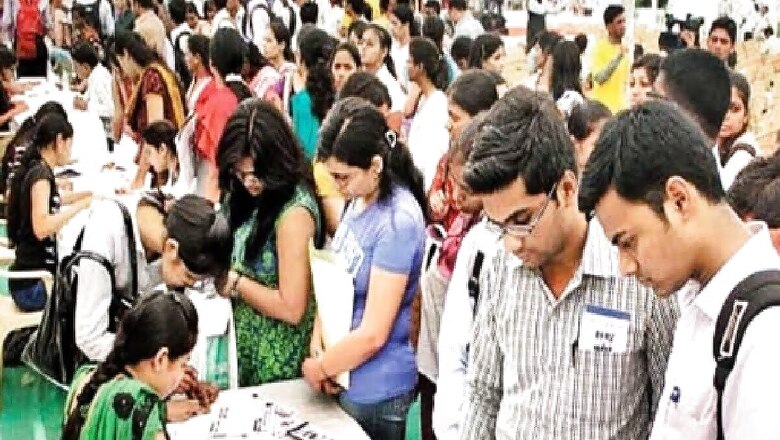
views
A wide disparity in the pass percentages of students from different school boards, large deviations in distribution of students in the major streams in different states, and different levels of assessment not allowing a level-playing field for all in major entrance tests conducted across the country—these are among issues identified in an analysis of class 10 and 12 examination results of all the existing school boards by the union ministry of education (MoE), which it said has prompted the need for the formulation of a common assessment system.
According to the analysis based on the 2022 class 10 and 12 exam results of all 60 school boards across states in the country, for instance, the pass percentage in senior secondary examinations for Meghalaya is 57% while for Kerala it is 99.85%. There is a huge disparity in the distribution of students opting for three major streams—science, arts, and commerce—in various states across the country. For instance, southern states have a higher percentage of students studying science while those opting for arts/humanities are much lesser here, the analysis shows. While Andhra Pradesh, Telangana, and Tamil Nadu have a much higher percentage of students studying science in higher secondary—76%, 65% and 62%, respectively—the number is much lower for several other states, such as Assam (17%), Haryana (15%), and Punjab (13%).
Only 2% students in Tamil Nadu, Andhra Pradesh, and Telangana have opted for arts but the situation is different for other states—Tripura (85%), other northeastern states (75%), Gujarat (82%), Punjab (73%), and Rajasthan (71%).
Similarly, while there are overall fewer takers for commerce, large variations were found for different states over the choice of the subject. While Uttarakhand has just 3% of overall students opting for commerce, in Karnataka, it is 37%. In Goa and Karnataka, the distribution of students is almost similar in major streams, the data showed.
“Science and arts have consistently been the most popular streams over the last 10 years. Students opting for science and arts streams have increased from 31% in 2012 to above 40% in 2022. The commerce stream has stagnated at the same level over the last 10 years with around 14% students opting for it. Students’ choice for vocational courses is also increasing; commensurate increase in seats at higher education level may be required,” the report said.
Also, in states having separate boards for secondary and higher secondary education, there is a large deviation in the performance of students between the two in the same state.
For example, West Bengal, which has two separate state boards for class 10 and class 12, shows a disparity in the results of students of the two boards. For senior secondary exams, 64% students have performed in the different marks range while for higher secondary, the figure stands at 58%.
“This might be due to different patterns and approaches followed by boards. Different boards are functioning at different levels. This analysis has given us a good rationale for the need of formulation of a common assessment method for all,” said Sanjay Kumar, school education secretary.
The ministry is set to carry out a preliminary study of 10 different state boards to have a deeper evaluation of how they fare in terms of quality of assessment and teaching. “The study will start this June and the final report is likely to be ready by November-December this year. We have written to all school secretaries for this,” he added.
The new National Education Policy (NEP) 2020 recommended the setting up of a National Assessment Centre, PARAKH (Performance Assessment, Review, and Analysis of Knowledge for Holistic Development), as a standard-setting body.
At present there are three central boards in the country—Central Board of Secondary Education (CBSE), Council for the Indian School Certificate Examinations (CISCE), and National Institute of Open Schooling (NIOS).
The analysis also showed that the top five boards—Uttar Pradesh (UP), CBSE, Maharashtra, Bihar, and West Bengal—cover about 50% of students enrolled while the rest 50% are enrolled in the remaining 55 boards across the country.
It also highlighted that state boards may also like to converge science syllabus with the central boards so that students have a level playing field for common entrance exams like JEE and NEET, which are conducted for entry to undergraduate engineering and medical courses, respectively.
The analysis also highlights that 11 states—UP, Bihar, Madhya Pradesh (MP), Gujarat, Tamil Nadu, Rajasthan, Karnataka, Assam, West Bengal, Haryana, and Chhattisgarh—contribute the maximum (85%) of dropouts.
“Mapping of failing students (around 46 lakh) of regular state boards with open boards and exchange of information can help in tracking and retaining students in the education system for a longer period. Presently, only 10 lakh students are registering through open schools,” the report stated.
Similarly, (around 12 lakh) students registered but not appearing can be mapped with the skill development department for tracking and training them. This will also help in improving India’s ranking in global indices, it added.



















Comments
0 comment